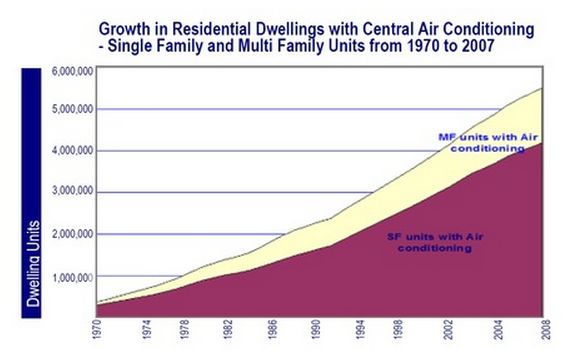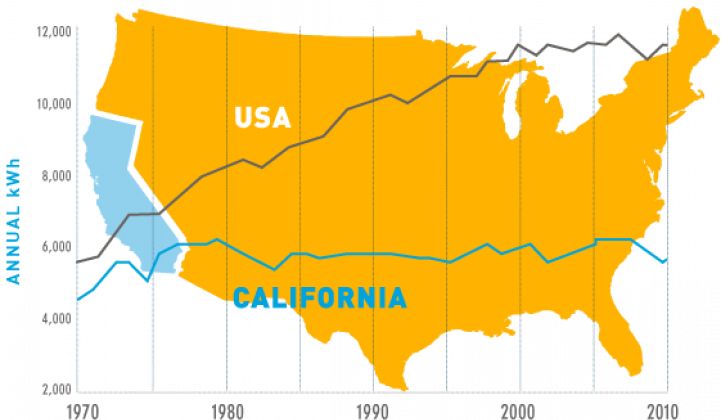California’s 40 years of remarkable success in using energy efficiency to avoid dirty power generation and save utility customers billions, as detailed in a new NRDC fact sheet released this week, offers valuable lessons to help meet President Obama’s climate action plan.
Cutting energy waste by improving the efficiency of America’s homes and businesses -- and the appliances and electronic devices within them -- is essential to reduce the nation’s need to build new power plants and to cut dangerous emissions from existing ones. Power plants are the largest source of America’s carbon pollution, and the president is ordering his administration to take steps to help curb it.
California’s energy efficiency achievements over the past four decades can serve as a model for how to avoid those dirty emissions. And, as we know well in California, investing in energy efficiency programs to allow us to do more with the same or less energy -- such as upgrading our lighting or weatherizing our homes -- also costs less than half the price of fossil-fuel alternatives. Efficiency also drives innovation and creates jobs.
NRDC is publishing a new fact sheet that highlights the enormous economic and pollution reduction benefits California has reaped thanks to its longstanding and bipartisan commitment to energy efficiency. Our paper also busts some of the myths about the reasons behind the state’s significant progress.
Efficiency’s huge benefits
California’s energy efficiency efforts over the past several decades have helped:
- Save residents and businesses more than $65 billion
- Make household electric bills 25 percent lower than the national average
- Create a more productive economy, generating twice as much economic output for every kilowatt-hour consumed compared to the rest of the country
- Decrease utility bills for millions of low-income households
- Cut as much climate-warming carbon pollution as is spewed from 5 million cars annually
Despite the state’s clear success, some naysayers incorrectly claim that it all would have happened even without our efficiency policies. But California policymakers and utilities know the facts: that’s why they continue to invest around $1 billion every year to expand on the state’s success with energy efficiency.
Utilities are required to turn first to energy efficiency to “keep the lights on” before investing in more expensive sources like natural gas-fired power plants. And the state sets standards for new buildings and appliances to minimize energy waste. Thanks in part to these efforts, California’s per capita electricity consumption has remained nearly flat over the past 40 years, while the rest of the United States increased by 50 percent.

Source: U.S. Energy Information Administration
California’s efficiency success can’t be “wished away”
Nonetheless, there are those who try to “wish away” California’s efficiency success by trying to prove that energy efficiency isn’t the only factor responsible for our flat per-capita consumption. Everyone knows multiple factors affect electricity use, but energy efficiency is a critical one. And just as you don’t have to be an only child for your parents to love you, efficiency doesn’t need to be the only contributor for it to represent an invaluable example to other states looking to cut utility bills and curb pollution.
NRDC’s new fact sheet debunks some of the “myths” detractors have used in an attempt to minimize efficiency’s importance, such as recent claims in a paper by Arik Levinson published by a nonprofit group called the National Bureau of Economic Research. It attempts to credit the per capita consumption disparity to the state’s mild weather while the population in the rest of the country shifted to hotter climates. However, this ignores that California’s population has also shifted into hotter climates in Southern California and the Central Valley.
The paper also contends that the state’s mild climate avoided air conditioning increases in contrast to other parts of the country, but the facts show otherwise. For example, only a quarter of new homes built in California in the 1970s had air conditioning compared to 95 percent of houses built in recent years, expanding home air conditioning’s 5 percent share of the state’s electric demand to about 25 percent.

Source: California Energy Commission
The lesson from California’s experience
As our fact sheet shows, California has demonstrated that energy efficiency can help keep the lights on, generate jobs, cut pollution, and lower utility bills. The state’s integrated effort to support research and development of new efficient technologies, utility programs that help consumers lower their bills, and minimum standards that ensure new buildings and appliances are not energy-guzzlers have been a resounding win for California.
The lesson from California’s efficiency efforts is clear: it works. And that’s a good lesson to learn for the sake of our communities and our nation as we join the president in taking the next big step to fight climate change.
***
Devra Wang is the Director of the California Energy Program at the Natural Resources Defense Council. This piece was originally published at NRDC's Switchboard and was reprinted with permission.



